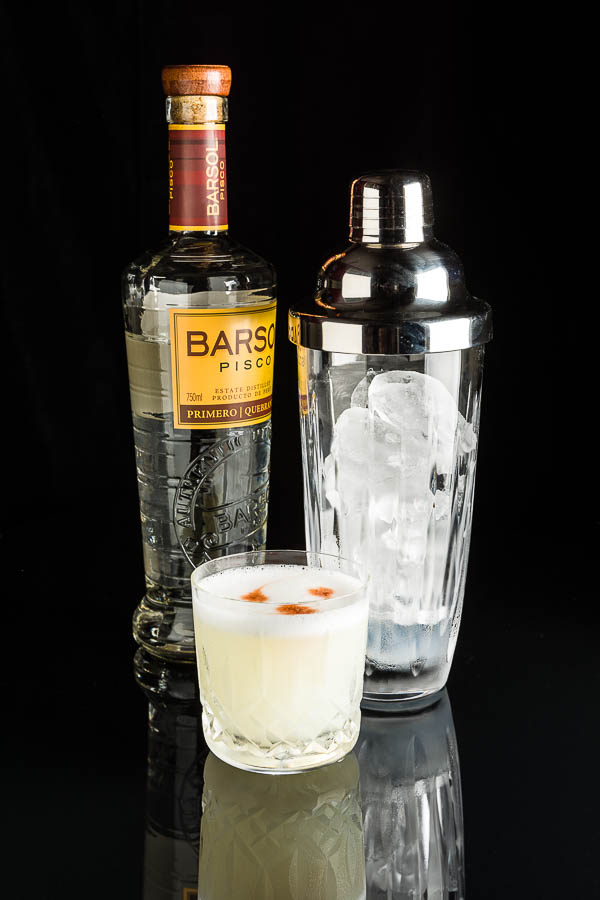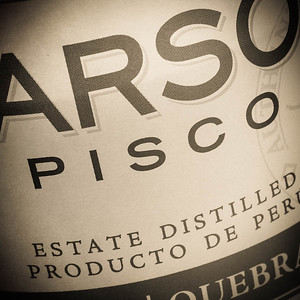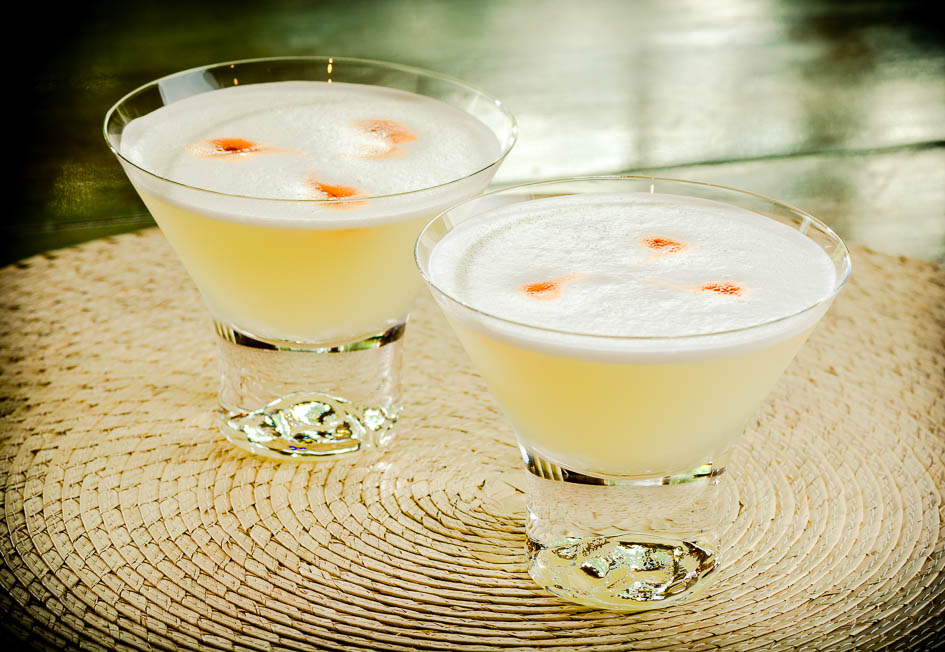We don’t often encounter the Pisco Sour, mainly because we don’t often encounter the Peruvian brandy called Pisco these days. (For that matter, we don’t seem to encounter very many brandy cocktails of any sort, but that’s another story.)
The Pisco Sour is a classic brandy sour, differing little from what we might call the Jerry Thomas brandy sour template. It uses lime juice (instead of lemon) to provide the sour component, but its hallmark difference is an ostentatious eggwhite foam.
There was a time when eggs—whites, yolks, or both—were common additions to shaken cocktails. The fashion fell out of favor decades ago, and now a luscious egg foam is a curiosity, the hallmark presentation of just a handful of drinks that survived evolution toward a foamless drink world. The Ramos Fizz is probably the most famous of the lot, and there are a few modern examples like Pip Hanson’s Oliveto. And there is the Pisco Sour.
There are only a two or three Piscos available in my market, all Peruvian. Peruvian Pisco tends to be light-bodied and slightly floral, even vegetal. There is no wood aging, so there are none of the oak flavors we associate with European-style brandies. I’ve never had Chilean Pisco, but it is said to be heavier, typically distilled from wine that has been aged in oak before distillation. I look forward to trying it someday.
History of the Pisco Sour
The Pisco Sour’s history is interesting in that, until recently, it seemed to be fairly well settled.
The generally accepted story was that the Pisco Sour was first formulated by Victor V. Morris, an American who left Salt Lake City for Peru in 1903 to work with a railway company in Peru’s mining regions. As the story goes, in 1904 he put together a celebration for the opening of part of the rail line, and, not having enough whiskey to serve whiskey sours to the crowd, substituted Pisco, and so the Pisco Sour was born.
That part of the story may or may not be true—it seems to be lore more than documented history. What we do know is that by 1916, Morris was in Lima, running his own well-respected bar, and that by 1924, a drink called the Pisco Sour was part of his advertised repertoire. And it was popular—enough so that other bars began copying it for their own clientele, and the Pisco Sour was off and running.
But in the last few years, historians have uncovered a couple complicating factors, so the story becomes much more fun.
The first complication is that a drink called the Pisco Sour was apparently well-known in San Francisco before Prohibition. We don’t know, of course, if it’s the same drink as the one served at Morris’ Bar in 1924, but the Sour is, and was, a pretty well-understood category of drink, and it’s reasonable to suppose that the pre-Prohibition San Francisco formula is very similar to Morris’s Lima formula.
The other significant issue is that the Pisco Sour recipe, with the simple name “Cocktail” was published in a 1903 Peruvian cookbook by S. E. Ledesma. Its appearance under such a generic name suggests that the formula had been in circulation, at least in Lima, for some time, just waiting to be attached to the name that would make it famous.
Whatever the case, it does seem that, at the very least, we have Victor Morris to thank for the refinement and promotion of the Pisco Sour, if not its original formulation.
Making the Pisco Sour
As with all sours, the Pisco Sour is an easy drink to make. The proportions are guidelines, and the trick, as always, is to balance the sugar and citrus so the drink is not too sour, not too sweet, and the flavor is driven by the primary spirit.

The Pisco Sour
- 2 oz pisco (BarSol Quebranta)
- 1 oz simple syrup
- 1 oz lime juice
- 1 egg white
- Angostura bitters for garnish
Dry shake the pisco, juice, syrup, and egg for a few seconds to froth the egg white. Add ice, and shake until very cold. Strain into an Old-Fashioned glass or a cocktail stem. Add dashes of bitters to decorate the foam.
The proportions here are the classic 2:1:1 sour ratio. Some drinkers find that formula too sour, but the egg seems to provide some softening of the lime’s presence, so unless the limes are particularly assertive, I stick with the classic ratio.
The “dry shake”—shaking the egg whites without ice—is a bit more messy and complicated than just adding the ice to the mix from the start. Some bartenders consider it unnecessary, since you can get a reasonable, if not lush, foam without it. If the foam is a distinguishing characteristic of the drink, as it is here in the Pisco Sour, the extra effort and the lush presentation it provides is worth the effort.
 The original Pisco Sour may have been ungarnished, but there is a tradition of topping it with one or more drops of bitters on the foam. (And as David Wondrich says in Imbibe!, “There’s no reason on earth not to do that.”) You’ll typically encounter Angostura, which is readily available and provides a good visual contrast with the egg foam. And since the foam makes an insulating cover for the drink, the choice of bitters drives nearly all of the smell of the drink as you lift it.
The original Pisco Sour may have been ungarnished, but there is a tradition of topping it with one or more drops of bitters on the foam. (And as David Wondrich says in Imbibe!, “There’s no reason on earth not to do that.”) You’ll typically encounter Angostura, which is readily available and provides a good visual contrast with the egg foam. And since the foam makes an insulating cover for the drink, the choice of bitters drives nearly all of the smell of the drink as you lift it.
The Pisco Sour is a reminder that there was a time before Prohibition when brandy was arguably the king of cocktail spirits—the Sazerac was originally a brandy drink; juleps were as likely to be make of brandy as whiskey; and the first entry in Jerry Thomas’s seminal Bartender’s Guide is the Brandy Cocktail.
The current interest in classic cocktails has brought our attention back around to the Pisco Sour, and to brandy in general as a cocktail spirit. I’m hoping the popularity of both will continue to rise, and they will both achieve the prominence they held before, and apparently during, Prohibition in America. The Pisco Sour is a delightful and refreshing drink, and deserves another chance at success.
“Mixing the Pisco Sour” at cold-glass.com : All text and photos © 2016 Douglas M. Ford. All rights reserved.

Are you a mind reader??? I was drinking PIsco Sours yesterday and thinking that I need a recipe. Delicious drink. Can’t wait to make my own. I think, though, that I will use Pisco Porton and garnish with a sprinkling of cinnamon instead of bitters (the latter is what the bartender does in our local Peruvian Restaurant; try it at least once). Thanks and Cheers!
No one has ever called me a mind reader, no.
So, cinnamon — great idea, I’ll try it. Thanks!
>
I have two Piscos in my home bar – the Peruvian Barsol Quebranta, and the Chilean El Gobernador. I must say – they’re stunningly different. I prefer the fruity, dense, malty and hoppy El Gobernador. A wonderful spirit, and fairly traded in addition.
I hope I can find some, to give it a try. You make it sound interesting. Thanks.
I’ve been seeing Pisco Sours all over the place in London recently, they’re definitely having a resurgence! I’m really enjoying your blog, your photographs are fantastic!
Sounds like London is well ahead of Minneapolis. I’m not surprised. Glad you enjoy Cold Glass, thanks.
You’re right. Far too neglected a drink. Gonna ask a silly question. Are raw egg whites safe ?
From my point of view: If you live in a country with somewhat high hygienic standards, care for eggs as you would for any perishable goods, use them early, and don’t buy the cheapest of the cheap, you’re safe.
I love egg white in drinks. But if you’re unsure, you could try bottled Egg White (available e.g. from Giffard).
I haven’t seen the Giffard product here, but thanks for the idea—I’ll watch for them and experiment. I have tried using the whites of pasteurized eggs. Alas! they don’t foam very well.
Safe, well, so far, so good in my experience. It’s my understanding that the risk of salmonella changes depending on where you live. I’m comfortable with my supply here in Minneapolis, and I feel the risk is low. I suppose we all have to be informed about the risks of our local supplies, and make personal judgments from there.
So I’d say that if you’re worried about it, don’t use egg in your drinks. That knocks the Pisco Sour off your menu, but it in my estimation, it’s not worth drinking something that worries you, and there are lots of other good cocktails.
Good question, thanks for asking.
I don’t remember the last time I saw a Pisco Sour on a menu. Maybe I’m going to the wrong places. They seem more concerned with mixing together as many different ingredients as possible then giving you a well-made, balanced drink. If it’s less than eight ingredients, then it isn’t a cocktail, apparently. Back to the basics,I say! Great photos, as always.
Hi, Robert, I’m “guilty” of posting a few drinks here that have long lists of ingredients, or mixes and infusions to be made ahead of time, but mostly I agree with you, yes, simple is good.
I tell myself the alcohol kills the germs. If that is not true, I do not want to know, because some of the yummiest drinks involve eggs and I don’t want to worry about getting sick. (Covering ears and eyes now, so I can remain blissfully ignorant!)
To Robert H. — I have only seen the PIsco Sour on the menu in Peruvian restaurants/bars. Have never seen it on a regular bar menu.
I’ve seen the hypothesis that alcohol kills any germs that might be in the egg, but never any conclusive testing. Maybe this is my chance to do a science fair project?
Thanks Doug. I’ve never had this drink, but I’ll have to pick up a bottle of Pisco and give it a whirl. The other night Ryan at Strip Club made a whiskey sour with a dash of Ango on the foam, and the additional aroma was very nice. Something to keep in mind for drinks with egg white.
Good thought, thank, Eric. I’ll have to get over to try Ryan’s whiskey sour.
>